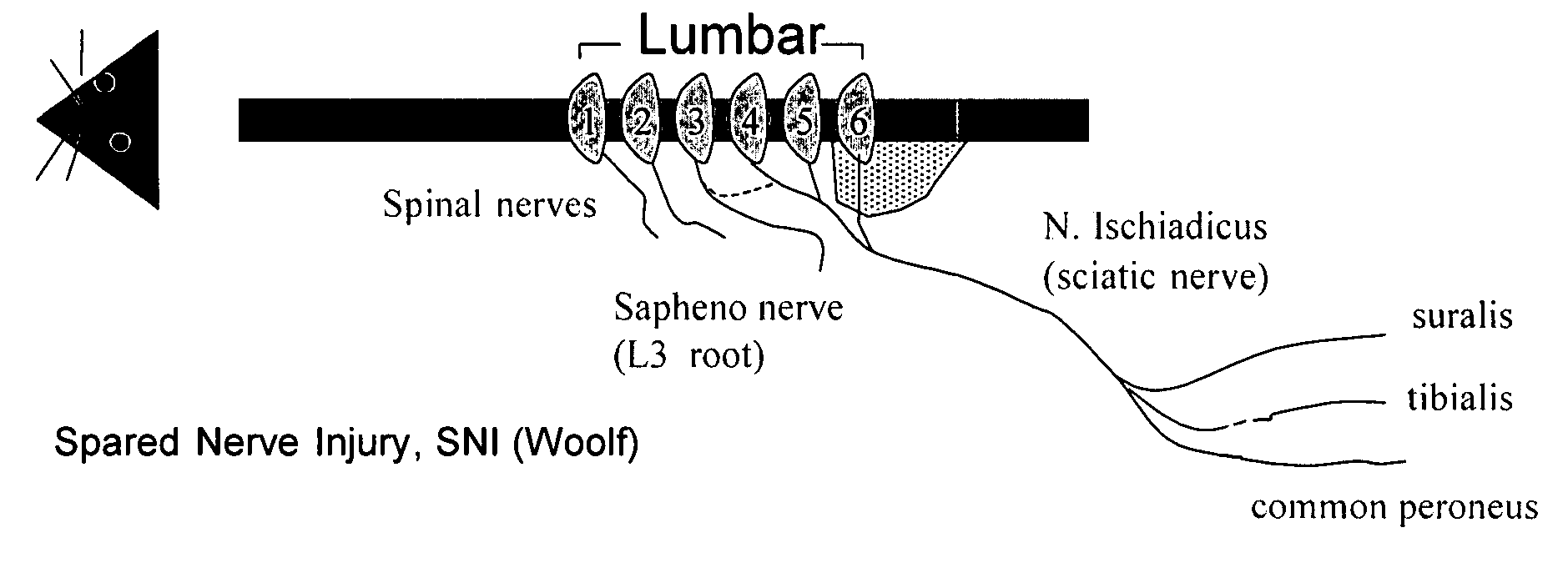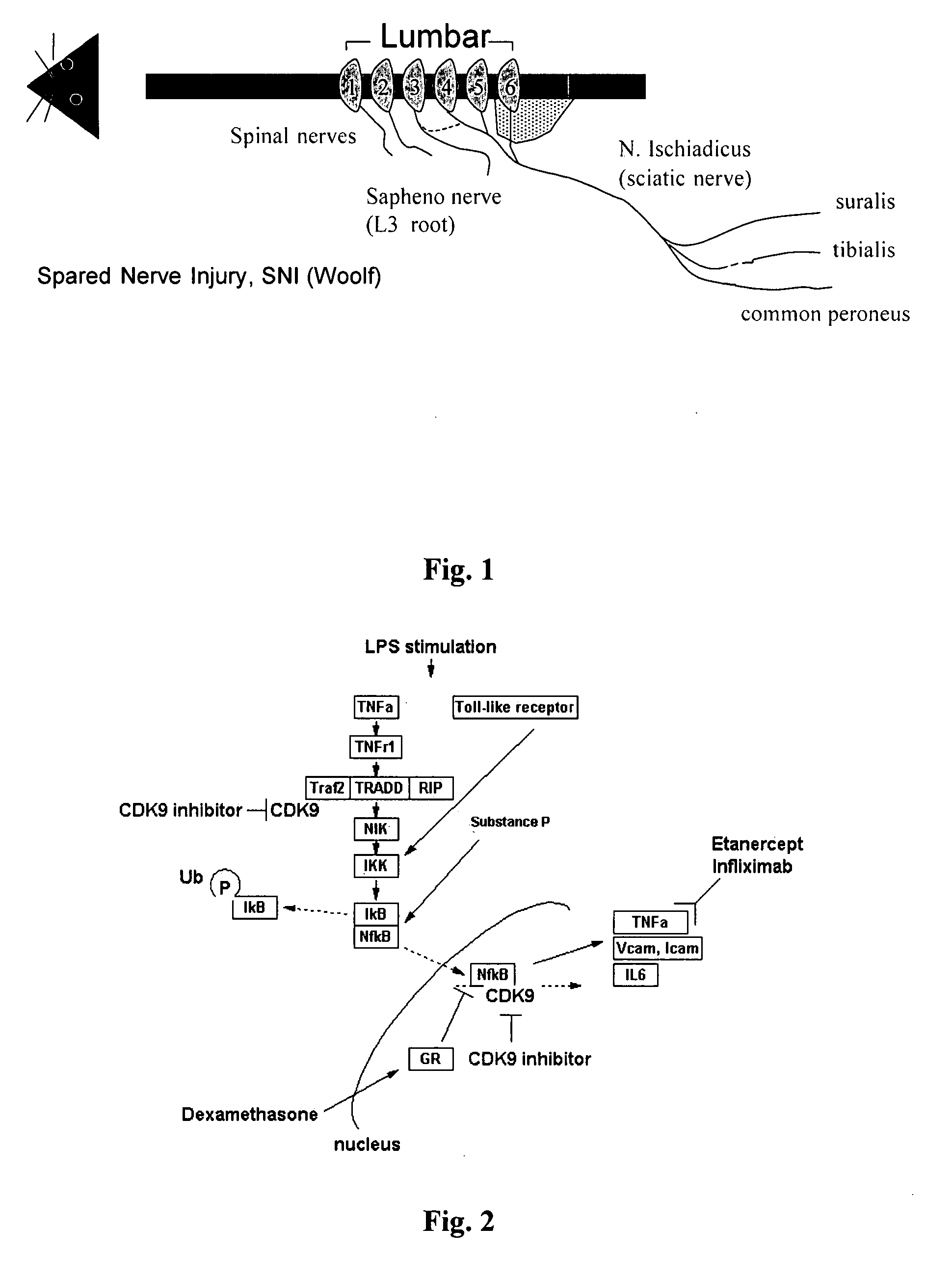Methods of treating pain
- Summary
- Abstract
- Description
- Claims
- Application Information
AI Technical Summary
Benefits of technology
Problems solved by technology
Method used
Image
Examples
example 1
A. Spared Nerve Injury (SNI)— Model of Chronic Neuropathic Pain
[0601]As outlined above, the spared nerve injury (SNI) model (see FIG. 1) involves a lesion of two of the three terminal branches of the sciatic nerve (tibial and common peroneal nerves) of experimental animals, leaving the sural nerve intact. SNI results in mechanical and thermal allodynia in the non-injured sural nerve skin territory (Decosterd & Woolf, Pain 2000; 87:149-158; Tsujino et al., Mol. Cel. Neurosci. 2000; 15:170-182).
1. Induction of Spared Nerve Injury (Nerve Lesion) in Wildtype Mice
[0602]Wildtype mice (strain C3HeB / FeJ) (age, sex and weight matched) were anesthetized with Hypnorm (0.315 mg / ml fentanyl citrate+10 mg / ml fluanisone; Janssen) / Hypnovel (5 mg / ml midazolam; Roche Applied Sciences) / water at a ratio of 1:1:2 at 4 μl / g prior to surgical preparation.
[0603]Subsequently, an incision was made under aseptic precautions in the ipsi-lateral right hind leg of all mice just above the level of the knee, expos...
example 2
A. Formalin Assay—Model of Inflammatory / Chronic Neuropathic Pain
[0618]The formalin assay in mice is a valid and reliable behavioral model of nociception and is sensitive to various classes of analgesic drugs (Hunskaar S & Hole K, Pain. 1987, 30(1):103-14.) The noxious stimulus consists of a subcutaneous or an intraplantar injection of 10 μl diluted formalin (2% in saline) into the left hind paw. The response is licking and flinching of the injected paw. The response shows two phases, which reflect different parts of the inflammatory process (Abbott et al., Pain 1995), an early / acute phase 0-5 min post-injection, and a late / chronic phase 5-30 min post-injection.
1. Injection of Formalin and Administration of CDK-Inhibiting Compound
[0619]Age, sex and weight matched wildtype mice (C3HeB / FeJ) were used in this assay. Prior to formalin injection, the animals were randomly subdivided into experimental groups of 10 animals each. Thirty minutes prior to formalin injection, CDK inhibitor (30 ...
example 3
A. Carrageenan Assay—Model of Inflammatory Pain
[0633]The model of carrageenan-induced paw edema constitutes a standard laboratory assay used to predict anti-inflammatory activity of therapeutically active compounds and reduction of inflammation-induced pain perception achieved by administration of therapeutically active compounds.
[0634]The basic measurement constitutes in the measurement of edema size and of mechanical as well as thermal hypersensitivity in response to irritants, such as carrageenan.
[0635]Inflammation and subsequent inflammatory pain is induced by subcutaneous injection of 25 μl of 1% carrageenan (in saline) into the hind paw (ipsi-lateral paw) of mice. Groups of 10 mice each received compound A, 30 mg / kg body weight, vehicle (DMA / Labrafil; 10:90) and saline (physiol. NaCl) by i.p. injection 30 min prior to carrageenan injection. Contra-lateral paws did not receive carrageenan injection.
1. Effects of Administration of Compound A on Carrageenan-Treated Mice
[0636]The ...
PUM
| Property | Measurement | Unit |
|---|---|---|
| Volume | aaaaa | aaaaa |
| Volume | aaaaa | aaaaa |
| Volume | aaaaa | aaaaa |
Abstract
Description
Claims
Application Information
 Login to View More
Login to View More - R&D
- Intellectual Property
- Life Sciences
- Materials
- Tech Scout
- Unparalleled Data Quality
- Higher Quality Content
- 60% Fewer Hallucinations
Browse by: Latest US Patents, China's latest patents, Technical Efficacy Thesaurus, Application Domain, Technology Topic, Popular Technical Reports.
© 2025 PatSnap. All rights reserved.Legal|Privacy policy|Modern Slavery Act Transparency Statement|Sitemap|About US| Contact US: help@patsnap.com



